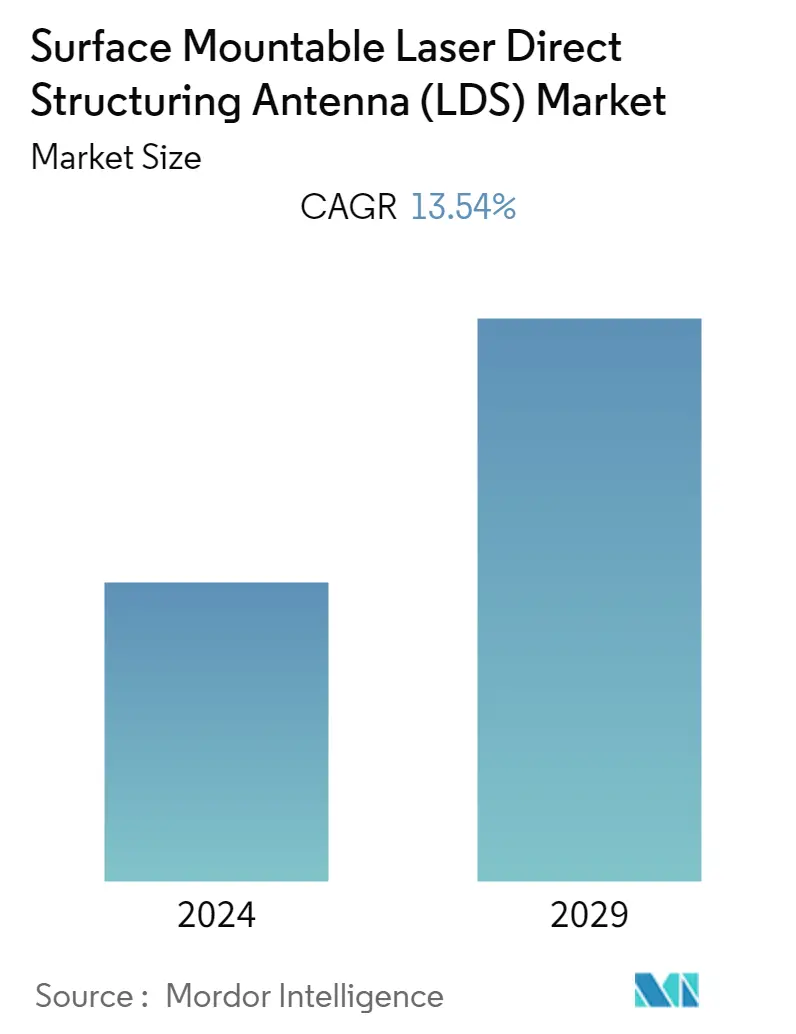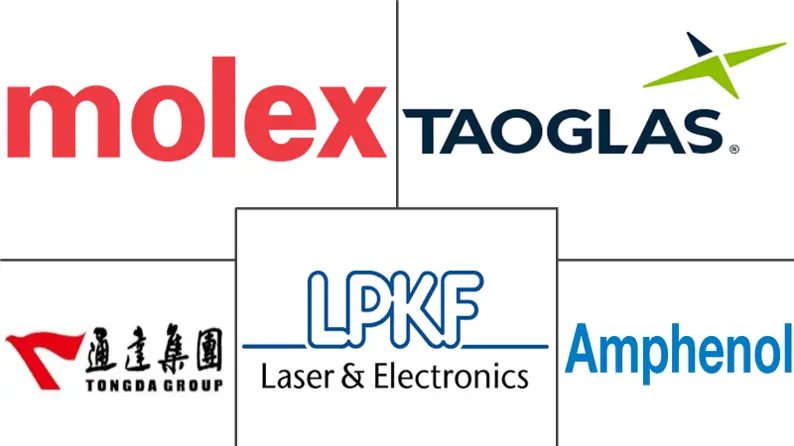Market Size of Surface Mountable Laser Direct Structuring Antenna (LDS) Industry

| Study Period | 2019 - 2029 |
| Base Year For Estimation | 2023 |
| CAGR | 13.54 % |
| Fastest Growing Market | Asia Pacific |
| Largest Market | Asia Pacific |
| Market Concentration | High |
Major Players
*Disclaimer: Major Players sorted in no particular order |
Surface Mountable Laser Direct Structuring Antenna Market Analysis
The Surface Mountable Laser Direct Structuring Antenna (LDS) market is expected to register a CAGR of 13.54% over the forecast period from 2021 to 2026. Antenna design with Laser Direct Structuring (LDS) technology offers the designers huge flexibility. LDS technology is one of the most advanced and robust 3D antenna manufacturing technology available. According to Multiple Dimensions AG, over one billion LDS antennas have been produced in the past decade. With LDS technology, antenna designers can create compelling antenna designs with new degrees of freedom in three dimensions. Multi-band, Bluetooth, Wi-Fi, CDMA, GSM, Cellular 3G, 4G LTE, and emerging 5G frequencies are served. LDS antennas cover the full spectrum of today's and tomorrow's mobile RF devices. Antennas manufactured using LDS are completely Surface Mount Technology (SMT) capable. Components on flat surfaces and the same level can be mounted using automatic assembly.
- LDS technology gives flexibility for geometric 3D design providing freedom in making antenna products beyond the previously often used flex circuit based antenna technologies. LDS is a better alternative to metal stamped or flexible adhesive antenna designs where the antenna's shape is too complicated or when the space allowed for placement is limited. Another one of the benefits of LDS is that the design frieze can be done much later. The users could till able to adjust the circuit artwork later on in the process, even if the parts are already molded or in the process of being molded. This flexibility and freedom enables to decide later on what type of structure one wants to put on. This is why cell phone antenna manufacturers prefer LDS so much as it allows them to fine-tune their antenna to get the best performance out of it before deciding on a design frieze.
- For the production of antennas in even the smallest electronic components, the 5G generation requirements can be a significant challenge. The aim is to achieve higher frequencies and higher data throughput. The Laser Direct Structuring (LDS) process key to this. It generates antennas for these high requirements quickly and easily on three-dimensional plastic components of any shape. There is no requirement for cost-intensive and loss prone connectors. The higher the frequency of an antenna, the finer its structures. Laser systems operate with high precision and can produce minimal structures with only 25 µm conductor path and insulation channel width. With antennas manufactured using the LDS method, the frequencies of 77 GHz required for 5G could be achieved.
- Modern automotive requires a wide array of sensors and assistive electronics, which increase the comfort and safety of the passengers in the vehicle. At the same time, the goal is to reduce the number of components used and significantly reduce manufacturing costs. Mechatronic Integrated Devices (MIDs), combined with the appropriate connection and assembly technology, is ideal for achieving these goals. It allows typical electromechanical functions such as buttons, plugs, and other connecting elements to be integrated into a single module, which serves as a molded interconnect device. Using the LDS process increases the available design options, accelerates modifications in electronic modules, and allows model variants to be produced cost-effectively, ultimately resulting in more profitable development and manufacturing.
- With the outbreak of COVID-19, various companies have been developing stamp-sized devices, comprising a suite of sensors, including ones that record body temperature and blood oxygen levels. This advance can be used to catch early signs and symptoms of COVID-19, and help monitor patients as the illness progresses. Small diagnosis and monitoring devices help to improve the lives of millions of patients. Combined with comprehensive wireless communication technology, this allows visits to the doctor to be reduced to a minimum. This development requires a more advanced manner of intelligently compressing more functions into a smaller space. With its precision and high reliability, the laser-based LDS process fulfills precisely these requirements.
Surface Mountable Laser Direct Structuring Antenna Industry Segmentation
Laser Direct Structuring (LDS) is a process that involves the designing of an antenna and produced onto a 3-dimensional plastic carrier. This carrier can be a separate plastic entity or an existing integral part of the customer's product's housing. The plastic carrier is an injection molded component, produced using a specific polymer material. The component is then selectively metalized using a chemical solution to create the conductive traces that form the shape of the antenna.
| By End-User Application | |
| Consumer Electronics | |
| Automotive | |
| Industrial Automation/IoT | |
| Medical | |
| Other End-user Applications |
| Geography | |
| North America | |
| Europe | |
| Asia-Pacific | |
| Rest of the World |
Surface Mountable Laser Direct Structuring Antenna (LDS) Market Size Summary
The Surface Mountable Laser Direct Structuring Antenna (LDS) market is poised for significant growth, driven by the technology's advanced capabilities in 3D antenna design and manufacturing. LDS technology offers unparalleled flexibility and precision, allowing for the creation of complex antenna shapes that are fully compatible with Surface Mount Technology (SMT). This capability is particularly beneficial for modern mobile RF devices, including those supporting multi-band, Bluetooth, Wi-Fi, and emerging 5G frequencies. The technology's ability to integrate antennas into compact spaces without the need for cost-intensive connectors makes it an attractive solution for industries such as consumer electronics, automotive, and healthcare. The demand for miniaturization and cost reduction in electronic devices further propels the adoption of LDS technology, as it enables the integration of multiple functions into a single module, enhancing design options and manufacturing efficiency.
The Asia Pacific region emerges as a key market for LDS technology, fueled by the high production of consumer electronics and the rapid development of 5G infrastructure. Countries like China, India, and South Korea are investing heavily in 5G, which is expected to boost the demand for LDS antennas in smartphones and other devices. The region's focus on advancing 5G technology, coupled with the increasing need for compact and efficient antenna solutions, positions LDS technology as a critical component in the evolution of mobile communication devices. The market is characterized by a few dominant players, such as Molex LLC and Taoglas Limited, who are actively engaging in partnerships and innovative solution launches to expand their market presence. Despite challenges posed by the COVID-19 pandemic, the LDS market continues to show resilience and potential for growth, particularly in the context of the ongoing digital transformation and the increasing demand for high-performance, space-saving antenna solutions.
Surface Mountable Laser Direct Structuring Antenna (LDS) Market Size - Table of Contents
-
1. MARKET INSIGHTS
-
1.1 Market Overview
-
1.2 Industry Attractiveness - Porter's Five Forces Analysis
-
1.2.1 Bargaining Power of Suppliers
-
1.2.2 Bargaining Power of Consumers
-
1.2.3 Threat of New Entrants
-
1.2.4 Intensity of Competitive Rivalry
-
1.2.5 Threat of Substitutes
-
-
1.3 Industry Value Chain Analysis
-
-
2. MARKET SEGMENTATION
-
2.1 By End-User Application
-
2.1.1 Consumer Electronics
-
2.1.2 Automotive
-
2.1.3 Industrial Automation/IoT
-
2.1.4 Medical
-
2.1.5 Other End-user Applications
-
-
2.2 Geography
-
2.2.1 North America
-
2.2.2 Europe
-
2.2.3 Asia-Pacific
-
2.2.4 Rest of the World
-
-
Surface Mountable Laser Direct Structuring Antenna (LDS) Market Size FAQs
What is the current Surface Mountable Laser Direct Structuring Antenna (LDS) Market size?
The Surface Mountable Laser Direct Structuring Antenna (LDS) Market is projected to register a CAGR of 13.54% during the forecast period (2024-2029)
Who are the key players in Surface Mountable Laser Direct Structuring Antenna (LDS) Market?
Molex LLC, Taoglas Limited, LPKF Laser & Electronics AG, Tongda Group Holdings Limited and Amphenol Corporation are the major companies operating in the Surface Mountable Laser Direct Structuring Antenna (LDS) Market.

